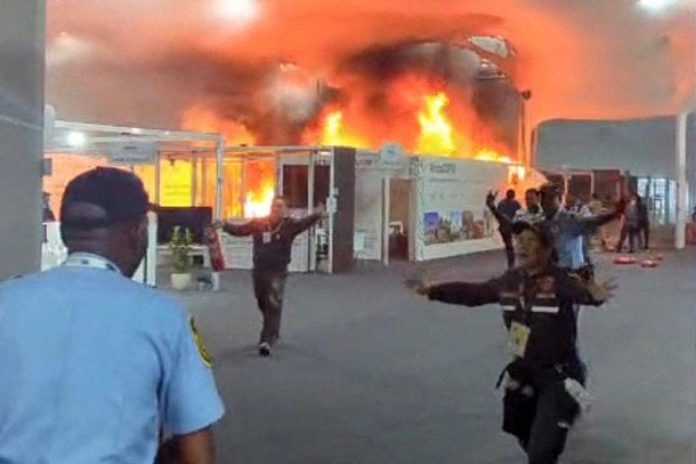This may be one of the more surreal moments in the recorded life of UN climate summits: negotiators arguing about the future of fossil fuels and billions of dollars in climate finance were sent tumbling out of a tented negotiation hall when orange flames punched a hole through the pavilion’s fabric, thick smoke rose into the Amazon sky and evacuations began on the penultimate day of COP30.
Watch video from CNN, here.
Reports suggest that the blaze started shortly after 2pm BRT (UTC-3) on 20th November inside the Blue Zone in Belém, Brazil; it was brought under control within minutes but left at least 13 people treated for smoke inhalation and closed the conference for hours, disrupting crucial final negotiations on finance, adaptation and the contested language on fossil fuels. Officials are probing whether an electrical fault or generator failure, some reports point to an overheating microwave, ignited the fire as delegates scrambled for the exits.
People who had been drafting compromise language, representing fragile coalitions and clutching annotated text fragments described scenes that were visceral rather than procedural: translators shepherding delegations into shade, medical teams reaching for oxygen, small teams of negotiators trying to salvage printed pages. The physical interruption translated immediately into political friction: negotiating blocs that had invested days of informal give-and-take found meeting rooms shuttered and the presidency’s timetable compressed; text that was supposed to be finalized was forced back into folders.
Reportedly, Brazil’s presidency had circulated a proposal that aimed to boost adaptation finance and frame a “mutirão” approach to accelerate the summit’s outcomes, but key elements, notably a roadmap toward fossil-fuel phase-out and a concrete adaptation finance timetable, were still disputed when the alarms sounded.
COP30 was already running against a tight clock. Delegations from nearly 200 countries arrived in Belém with competing expectations: vulnerable nations demanded predictable, grant-heavy finance and clearer mechanisms for loss and damage; wealthier states sought political cover for incremental, market-oriented measures. The draft circulating in the final hours reportedly included calls to triple adaptation finance by 2030, a headline that would be consequential if translated into verified commitments, but the draft lacked a credible roadmap for where those funds would come from, and that absence was one of the thorniest sticking points in the rooms when the fire struck.
Delays of hours can matter at the end of a COP: compromises that might have been brokered in the last evening are harder to stitch together when chief negotiators are dispersed and text must be reconvened under stress.
For the African continent’s own climate plans; the aggregate of Nationally Determined Contributions submitted under the Paris framework, imply capital needs measured in the trillions: independent assessments place the cost of implementing African NDCs at roughly USD 2.6–2.8 trillion for the decade to 2030, and researchers estimate Africa faces annual adaptation and loss-and-damage burdens that run into the tens of billions each year.
These numbers determine whether ports, roads, power grids and hospitals will be climate-resilient or repeatedly rebuilt. African negotiators who had planned to press for direct-access funding mechanisms, clearer debt-relief pathways for climate investment, and binding windows for adaptation finance risk losing leverage when table time is eroded by events like the Belém evacuation.
The disruption at Belém also exposed the brittle logistics that undergird even the highest-profile global diplomacy. The COP30 site relied heavily on temporary structures, extensive cabling and satellite facilities to host tens of thousands of participants; those same expedients that make a remote summit possible in the Amazon also introduce fire and electrical vulnerabilities.
The images and videos showing flames racing up fabric linings, smoke streaming through seams, mirrored incidents in other parts of the world where convention centers under construction or dependent on temporary systems experienced major fires, with long operational and economic knock-on effects.
The New Zealand International Convention Centre fire in Auckland, for example, burned for days while under construction and forced prolonged shutdowns in a city center; that event is instructive because it underscores how construction-phase vulnerabilities and combustible cladding or membranes can convert a local incident into a civic crisis. The COP30 blaze was smaller and quicker to extinguish, but the optics are immediate and damaging: a summit convened to discuss resilience and infrastructure safety was itself interrupted by what appears to have been an infrastructure failure.
History shows that shocks to conference logistics can cascade into political losses. The Paris COP21 year remains a touchstone: the November 2015 Paris attacks did not cause a venue fire, but they did curtail public mobilization, increase security restrictions and reframe the political atmosphere in which the climate agreement was negotiated. In other cases, large protests at Copenhagen in 2009 and the police response altered the space available to civil society and shaped the negotiating environment.
Those precedents demonstrate how security and safety incidents; whether violent, infrastructural or environmental, can change negotiating dynamics by constraining who is present, who can speak, and how much bandwidth remains for technical compromise. The Belém evacuation similarly compressed the window for the final political horses-trading that determines whether promises become operational commitments.
Beyond symbolism, there are concrete dossiers at stake that will matter to African development trajectories if they are deferred or diluted. The roadmap toward fossil-fuel phase-out, a demand backed publicly by more than 80 countries at COP30, is a central fault line: language on “phasing out” versus “phasing down” fossil fuels shapes whether international finance and technology transfers will prioritize renewable industrialization or continue to accommodate new gas and oil infrastructure that many African governments see as a short-term tool for energy access and revenue.
Meanwhile, the shape of any agreement on adaptation finance, proposals circulating that aim to triple adaptation funding by 2030, will determine the scale of concessional grants and concessional credit available for coastal defenses, drought-resistant agriculture and urban flood control. If those items are parked, left vague or converted into non-binding political exhortations, African ministries that plan multi-year capital programmes will face greater difficulty convincing investors and parliaments to allocate scarce resources.
Engage with us on LinkedIn: Africa Sustainability Matters






